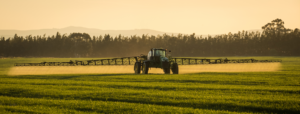Menu
Water pH Influences Pesticide Efficacy
The pH of water does impact the efficacy of many pesticides.
When water pH is too high, alkaline hydrolysis is likely to occur, causing pesticides to significantly degrade, sometimes to the point that they become inactive. This degradation often happens in the spray tank before the pesticide reaches its intended target.
Water sources are important for pesticide application. It is essential to test your water source so you know what pH you are starting with. Many wells in Pennsylvania will typically be between 7.5 and 8.5 pH. Pond water is usually higher in pH, starting around 8.0 pH in the spring and increasing to 9.5 pH or so as the weather warms up. Rivers and creeks can vary significantly but are generally slightly lower in pH than pond water.
During tank storage, the water’s pH will increase. If you spray and refill frequently, you can pretreat your storage tank. Acidifying water in a holding tank will not maintain its acidity very long, so we recommend conditioning your water as you load the sprayer as much as possible, using products like Turbo, TurboCharge, or Vaporize when you need an acidifying agent.
It is important to know the pesticide pH requirements; most of the time, the label will direct you to the appropriate water conditioner. However, using multiple pesticides in the same tank mix can become very complex because a few active ingredients require a higher pH. If you have questions, ask your pesticide supplier for assistance.
If your water is above 7.0 pH, it is generally recommended that you acidify your tank mix. Many pesticides work well in a spray solution around 5 pH, and products like glyphosate benefit from an even lower pH.
We’re approaching a time in the season when many growers may be applying an insecticide like dimethoate. This is an example of chemistry that is very sensitive to pH. If your water supply is 9.0 pH, the half-life of dimethoate is about 48 minutes. If you use high-pH water and apply dimethoate, the efficacy drops by half in less than an hour. In contrast, if you acidify the tank mix solution down to 5 pH, the half-life of dimethoate extends to 20 hrs. Captan is also a widely used fungicide that is very sensitive to pH. A pH of 8.0 will reduce the captan half-life to 10 minutes. Reducing the pH to 7.0 changes the half-life of captan to 8 hours. That’s a 48x increase in the efficacy of captan simply by lowering the pH from 8.0 to 7.0. Saflufenacil is a herbicide on the other end of the spectrum and needs a pH above 7.0 to maintain efficacy, so check each label carefully.
The pH of your water can quickly impact the chemistry’s ability to kill the target pest. These are just a few illustrations of the importance of managing your pH, so following each pesticide’s label is necessary.

Water hardness is another aspect of your water condition. Calcium and magnesium are the primary drivers of water hardness, but iron and sodium can also contribute to the problem. Since calcium and magnesium are positive cations, they typically bind up a negatively charged pesticide, reducing its ability to perform. Many pesticide labels call for adding a non-ionic surfactant, such as Spreader820 or Spreader910, to the solution. These products help neutralize the influence of negative anions vs. positive cation charges in the tank mix, helping with tank mix compatibility and improving your pesticide performance.
Here at PowerAG, we’re always happy to help you find the best options for your farming operation. Call us today for all your water conditioning needs.
DISCLAIMER: This blog is for educational purposes only. Where trade names appear, no discrimination is intended, and no endorsement is implied. All trademarks and logos are the legal rights of their respective owners.
© PowerAG.com - All Rights Reserved.

